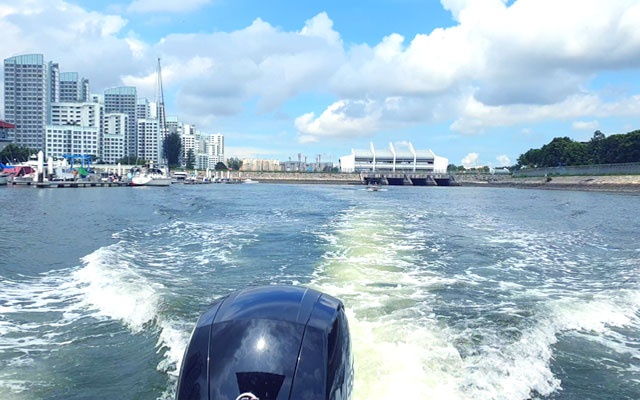We are on board a half-cabin cruiser, in the midst of the water border that Singapore shares with Malaysia, skimming past kelongs, mangrove swamps and wild boars scavenging for food on deserted beaches. Overhead, we spot a white-bellied sea eagle gliding through the air every now and then, and a low-flying Emirates aircraft – a rare sight these days – cruising past the skyline. This is home, truly… like nothing that we’ve seen before.
Bringing us on this joyride exploring kelongs, or floating fish farms, in the north-eastern banks of Singapore is Robin Loh, founder of Let’s Go Tour Singapore. Priced at S$450 (US$330) for a maximum of five persons, the two-hour Let’s Go Kelong Tour was a breeze to put together for Loh, who has spent over 20 years fishing for leisure in this coastal area.

On this balmy Friday afternoon, our tour starts with a few Covid safety measures. We are given a contact tracing form to fill out. According to Loh, the names are compiled and sent to the Singapore Tourism Board on a weekly basis. Masks have to be kept on throughout the tour – for both the guide and guests.
Temperature checks are also part of the drill. We cleared a temperature check at the entrance of the Marina Country Club, where Loh’s boat is parked, and checked in via SafeEntry. As part of further safety measures, Loh said boat seats are wiped down using disinfectant at the end of each day.
The boat tour is part of the agency’s This Is Home series, a collection of educational and interactive tours made for locals. Loh turned to domestic tourism to keep his tour business afloat amid the travel slump. Now, it seems the tides are turning for Loh, with the kelong tour reaping a harvest, netting about 30 bookings within less than two months of its launch.
In this Covid era, privately-hosted boat tours that promise ultimate safety have proven an attractive lure, especially with family groups, as people are “very scared” of contracting the virus. When international tourists start to trickle back, Loh said, this new collection of products could be marketed to them as “whatever is suitable for locals would be a hit with foreign tourists”.

Today’s tour brings us on a journey to see sights beyond the picture postcard image of the island city. Notable sightings along the way include the Singapore offshore islands of Pulau Ubin and Pulau Tekong, cluster of kelongs, a high-tech fish farm, and the now-infamous S11 dormitories, aka Singapore’s largest Covid-19 cluster. From our vantage point, we espy the cramped conditions of the dorms, fringed by double barbed wire fences, not unlike that of a prison or detention camp. Just across, blocks of government-commissioned flats stand tall, unfenced. I’m guessing this is what inequality looks like.
Along the tour, we learn fascinating nuggets about kelongs and why traditional fish farming is a “risky” business. Loh regales us with riveting anecdotes of his sightings at sea from two decades ago, involving smuggling and high-speed boat chases. Unlike bigger group tours, where dialogue is usually a one-way street, we get to fire away our burning questions at the chatty and affable Loh, who expertly fields all our queries.

Our trip concludes with a stopover at what Loh called the “last full kelong in Singapore”. Unlike other kelongs, this one has two long rows of wooden stilts built in a V-shaped structure to herd fish into the lift net hoisted at the centre where the kelong stands. These small fishes are then fed to farm fishes, which are harvested for sale. When we floated the idea of incorporating a land visit to one of the kelongs for a more immersive experience, as opposed to just viewing from afar, Loh said the concept is not feasible now as there is no dock on the site, but added that they are exploring the idea.
For those craving to return to the days of yore, or those curious about what Singapore circa 1960s looked like, the tour harkens back to the city-state’s humble beginnings as a Malay fishing village. As engaging as it is educational, the boat tour makes a nice change of scenery from the usual land tours, while spotlighting a slice of Singapore’s history forgotten amid the march of rapid urbanisation.
When we finally return to shore, the whole vibe around the jetty, not to mention the old-school, non-airconditioned F&B venues within the compound, makes us feel like we are still stuck in a time warp. But as we make our way out of the premises, we are stopped at the entrance by the security guard who gestured towards the designated exit, prompting us to check out via SafeEntry, and reminding us once again that this is 2020.




















